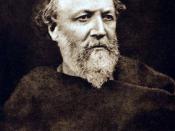Many poems must be read several times to be fully understood. It is often that one may find something of interest that was missed the first time around. It is also possible to have read a poem once and receive the full meaning. Sometimes a poem will leave one to think because the poem did not provide enough information for an affirmative conclusion. My Last Duchess provides an example of leaving readers unclear of the full meaning and implies several things. The poem My Last Duchess does a perfect job of giving enough information to portray the Duke as a sick and extremely jealous individual, but leaves just enough to the imagination to come up with your own conclusions and twist the story to your own liking.
My Last Duchess written in 1842 by Robert Browning is the dramatic monologue about the Duke of Ferrara who is negotiating his second marriage through an agent of the count of Tyrol.
The dialog is exchanged on the grand staircase of the ducal palace at Ferrara in northern Italy. A dramatic monologue is a kind of narrative poem in which one character speaks to one or more listeners whose replies are not given. Therefore, the reader never gets to hear the replies of the agent to the count of Tyrol and at first the reader almost feels the conversation is addressed at the reader. Executing the elements of a dramatic monologue, the Duke reveals his situation and much more than he intends to the both the agent and the reader. The Duke starts of the poem with admiration for his Duchess that he painted a painting of, and the reader quickly discovers the Duke's perverse thoughts.
Robert Browning reveals the horrifying story of the Duke negotiating the terms of a new marriage agreement.


